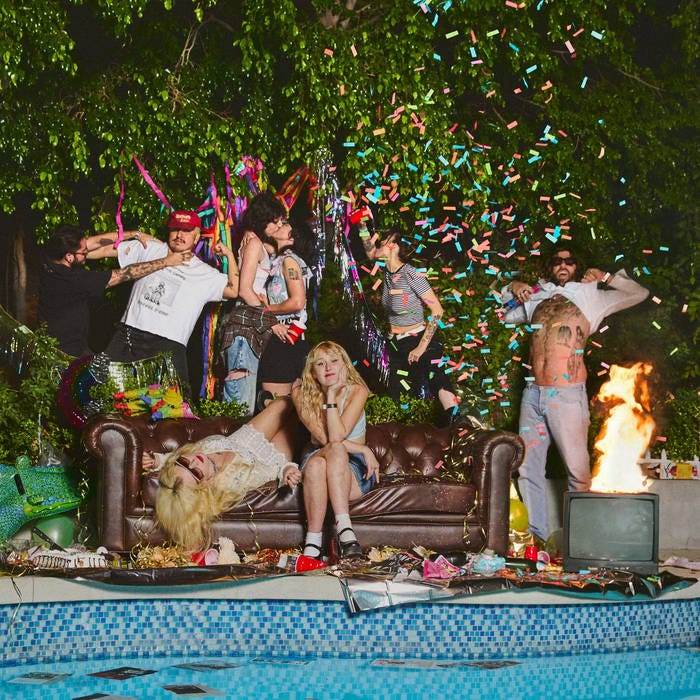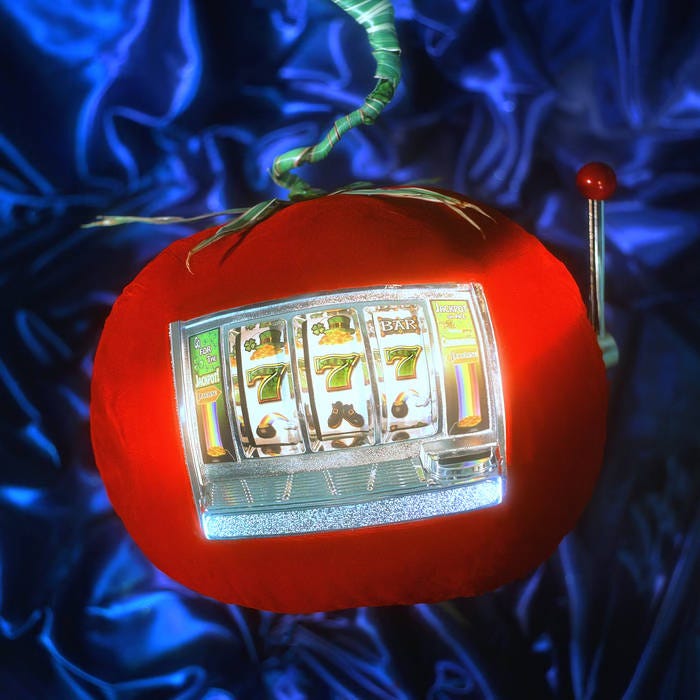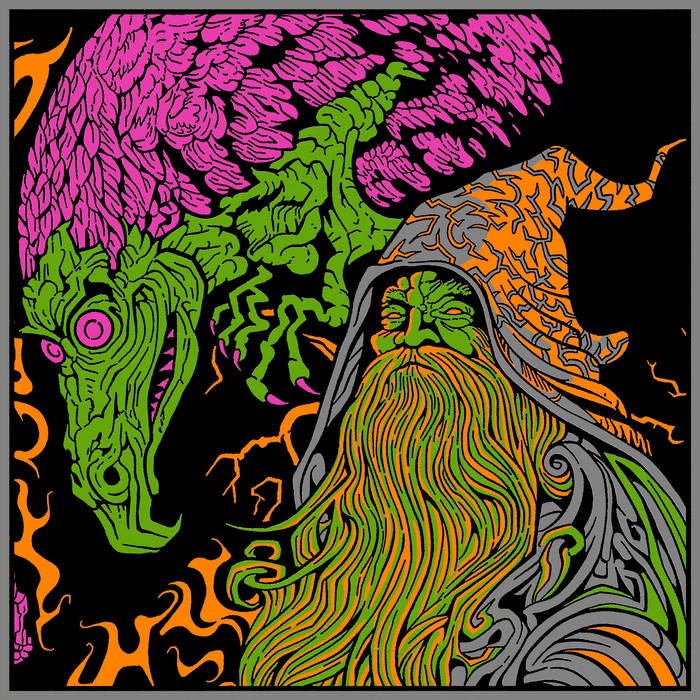Well, if the cold covering much of America hasn’t sent you looking for musical warmth, then perhaps the politics of the first week of the Trump Administration has you needing a salve (or three). Though the liquor cabinet may beckon, it’s music that’s (almost) always the first place we turn to for comfort, relief, and joy here at 3A6OG HQ. So we decided this would be a good time to share a lot of music at once, with multiple albums in every category: 8 great new releases, 2 bands who put on a blistering live show, and 8 (mostly classic) artists whose catalogues can feel daunting, but OG Brian is here to help you get started. Stay warm and safe.
New album(s): As we noted in our end of year lists, 2024 was a phenomenal year. Well, at least for music. And if the first few weeks of January are any indication, we have an even better year in store for 2025. Well, at least for music. So as you try to fulfill that New Year’s resolution to listen to more new music and see more live shows, here’s a quick rundown of some great new albums that deserve your attention across several genres:
Who Let the Dogs Out by Lambrini Girls — This is the album of the month for me, so far, and only moreso since President Trump took office. As their Bandcamp page says, the album has “instrumentals that inhale you like a Level 5 tornado and sentiments that make you want to kick the nearest door through.” True that. The album is a glorious and invigorating political punk ride, with angry yet often slyly funny lyrics, blistering guitar, and driving drums. It’s 1970’s and 1980s punk reborn with the issues of today - gentrification, police violence, toxic masculinity, homo- and trans-phobia, body image, and more. The standout, though, is “Big Dick Energy,” which feels even more appropriate after week 1 of the Trump Administration. The music grooves just that much more, and the venom in lead singer Phoebe Lunny’s voice when she reminds her target “it’s really not that big” is just phenomenal. I wrote about their exhilarating full-throttle live show here, and the band will tour the U.S. this spring; don’t miss them.
How Lucky to be Somebody by Little Oso — When you need to come back down to earth and have a slightly quieter and more twee listen after Lambrini Girls, but still have a melodic and catchy vibe, this band from Portland (Maine, that is) has got all the elements of what the other Portland specialized in during the 1990s.
Out from Underneath by Prism Shores — OG Brian said multiple times in 2024 that “jangle pop was having a moment.” This Montreal band appears determined to make sure that moment continues in 2025, at least on the power end of jangle. “Tourniquet” is just one of many songs that will make you wonder whether you’ve stumbled on a Teenage Fanclub B-side.
And That’s When I Saw Gawd by Observe Since ’98 and Ferris Blusa — Observe Since ’98 is a Madison, WI producer who caught my ear in 2021 and has been churning out records, mixtapes, and beats at a remarkable pace. But this one has hit me much more directly than anything else, especially because of the vibe and bars brought by New Orleans MC Ferris Blusa. Popular music taking on organized religion is of course nothing new — would most of heavy metal exist without churches? — but Ferris’ lyrics are deft and sly as he unpacks the hypocrisy of modern megachurch preachers, especially those rooted in the Prosperity Gospel, with some jaw-dropping samples woven in.
Heritage by Songhoy Blues — One of my favorite Malian bands returns after nearly five years away with a quieter, more introspective set. Their past releases — 2020’s Optimisme and 2017’s Resistance - were much more electric, bluesier, and sweatier. The new release is much more acoustic and meandering, perhaps reflecting the challenging state of Malian politics or just a maturing band.
Baarakelaw by Samba Toure — Germany’s Glitterbeat Records, which emerged as a favorite label of mine in 2024 — just check out this incredible comp from their year — begins 2025 with a phenomenal album from another Malian musician. Samba Toure is not related to Ali Farka Toure by birth but certainly is by musical genes.
talulah’s tape by good flying birds — This is a collection of the last 4 years of demos and singles from Indianapolis band good flying birds, released on excellent St. Louis label Rotten Apple (which put out some favorites of mine in 2024, including the Submissives and the Soup Activists). Super catchy jangle indie pop; less power pop than Prism Shores with a gloriously lo-fi feel.
Please Don’t Get Cocaine in the Faders by SoLaRfIvE — To be honest, the album title may be the best thing about this record, and if that’s all it is, it’s still great. The lyrical flow is hard to grab on to at times, but this Chicago MC is pushing some boundaries, and it’s a ride worth a couple spins.
(Brad)
Album from an upcoming/recent show: Triple Seven by Wishy (Bonus: Under Sound by Prize Horse). The ‘90s are back! The past few years have brought sequels to Top Gun and Twister. HBO has a new hospital show coming soon that is absolutely, positively not a continuation of ER. Singles are being dropped by the likes of Guided by Voices and Kim Deal, while The Hard Quartet is musical fantasy-casting for a certain type of Gen Xer (such as myself). And Diddy’s white parties are constantly in the news, but for… uh … different reasons.
From shoegaze to alt-rock to jangle pop to low-fi, the music of the ‘90s is having a significant influence on many current new bands (I’m hoping we will skip over nu-metal, but not terribly optimistic). On November 22, at DC’s Songbyrd, I saw two bands that take different approaches when incorporating ‘90s influences - headliner Wishy, from Indianapolis, and touring opener Prize Horse, from Minneapolis (apologies to local opener Aunt Katrina - I arrived just as your set was ending, but I liked what I heard).
Both bands’ sets drew heavily from their 2024 releases. Wishy’s Triple Seven, released back in August, is an album that I’ve repeatedly gone back to the past few months and one of the most enjoyable of the year. The band is led by singers/songwriters Kevin Krauter and Nina Pitchkites, and their three-guitar-plus-rhythm-section lineup produces a sound that combines power pop, post-grunge, and the occasional dash of shoegaze. Like their album, Wishy’s set was upbeat and energetic. And while at most shows I see people (ok, dudes) standing still and nodding their heads, Wishy’s set caused men and women around the room to dance. Like, actually dance (yes, kids, there was a time when people danced to rock bands; ask ChatGPT).
“Sick Sweet,” the album opener and one of the standout tracks on Triple Seven, absolutely rocked live. Singing about a one-sided crush (“Dealing a guilty plea to my loneliest hear’s desire”), the song pairs well in terms of subject matter with the title track (“I wanted to know you / But you never came around”), which is dreamier on record than on stage. “Love on the Outside” exudes FM radio blasting (again kids, ask ChatGPT) and windows rolled down.
Wishy’s three guitars really come through on “Game,” a frenetic distortion- and solo-filled blast. The same can be said for album closer “Spit,” which echoes mid-‘90s alt-rock and turns the chaos levels up to 11. “Just Like Sunday” showcases Pitchkites’ softer, more emo side (“These days are gonna leave me in the rain”) while “Busted” combines catchy hooks with Krauter’s distorted vocals. “Persuasion” is the jangliest song on Triple Seven and shows Krauter and Pitchkites sharing lead vocals on a track that would be perfect for the next generation of teen movies, except that most kids don’t seem to give a hoot about indie rock (or, for that matter, movies).
Prior to the show, I was less familiar with opener Prize Horse, but I really dug their set. They are a heavy guitar-bass-drum trio. As with Wishy, Prize Horse drew primarily from their February release Under Sound, and they also demonstrate clear ‘90s influences. But whereas Wishy combines Teenage Fanclub with Do the Collapse-era Guided by Voices, Prize Horse opts for more of a post-hardcore sound. Prize Horse falls somewhere on the spectrum between early Dinosaur Jr. and The Jesus Lizard, with maybe a little bit of alt-rock-radio-friendly Seven Mary Three mixed in (but less… uh… cumbersome).
Songs like “Reload,” “Further From My Start,” and “Dark Options” are excellent examples of Prize Horse’s loud-quiet-loud sound that, thanks to the band’s propulsive rhythm section (drummer Jon Brenner and bassist Olivia Johnson), maintains its heavy feel even when singer-guitarist Jake Beitel pulls back a bit. Whereas on “Stone” and “Know Better” the trio are going full throttle. It’s fun when an unfamiliar opening act grabs my attention, and I’ll be keeping an eye on Prize Horse going forward.
Everything old is new again. Or so we’ve been told. So I guess it shouldn’t be a surprise that the music of the ‘90s, the decade in which I spent most of my 20s, is now influencing musicians who are currently in their 20s. This idea was perfectly encapsulated by the most surprising moment of the show, when Wishy played a fantastic cover of R.E.M.’s 1991 hit “Shiny Happy People” (would not have been in my top 20 guesses for R.E.M. covers but it really worked). I got on board the R.E.M. train with 1986’s Life’s Rich Pageant and continued through 1995’s New Adventures in Hi-Fi (after which, periodically checking in up to and including the first 15-20 seconds of “Supernatural Superserious”).
For my generation, “Shiny Happy People” was one of the sellout songs from the sellout album (Out of Time) in the decade when selling out was the worst thing you could do. But the kids in Wishy (and Prize Horse) don’t have that baggage with ‘90s music. They most likely heard a fun pop song by a legendary band and didn’t care if, in 1991, it was overplayed or was deemed to have “uncool” lyrics. It will be interesting to learn what resonates with newer bands as they listen to ‘90s music with fresh ears. Can we just agree on one thing? No Limp Bizkit, please. (Brian)
Album (um, bands) being rediscovered (at least 10 years old): I’ll start 2025 off with another peek behind the 6OG curtain. Our group chat runs the gamut. Topics range from music, to sports, to current events, to careers, to parenting. And the tenor of our discussions can range from thoughtful, to curious, to downright absurd (one day maybe we will release for public consumption all of our suggested sequels and spin-offs to an actual, real Prince-centric children’s book).
A recent discussion thread led to the subject of artists or bands that have a barrier to entry (I won’t say what led to this subject because, well, you’ll have to read further to find out). What do I mean by “barrier to entry”? I’m referring to artists or bands that don’t have an obvious starting point, likely due to a massive catalog, the lack of a single signature album (or albums), a long career that contains several different eras and high points, geographical divides, or some combination of all the above.
To illustrate, I’ll use one of my favorite bands as an example of a group that does not meet the barrier to entry definition – Guided by Voices. GBV have released 40 proper studio albums (with another due out in ’25) and gone through numerous lineups and eras since their founding in 1983. This output does not even include all the Robert Pollard solo releases and side projects, like Boston Spaceships and Airport 5. Despite this seemingly overwhelming catalog, it’s widely accepted that the best starting point for anyone getting into GBV is 1994’s Bee Thousand and 1995’s Alien Lanes. Easy entry point = no barrier.
Below I’m listing out several artists and bands that I’ve identified – with some assists from the other OGs – as having barriers to entry. Some reflect personal experiences with artists or bands I’ve been unable or unwilling to wrap my arms around, while others I am a fan of but acknowledge there may be obstacles to a newbie finding an entry point (and in those cases I might be able to offer a suggestion). This list is a little shorter than others I’ve published, and I’ll start with the band that kicked off this topic in the 6OG group chat…
King Gizzard & the Lizard Wizard: This genre-bending Australian band has such a barrier to entry I’m not even sure how to start writing about them. Their impossible-to-define sound incorporates diverse musical influences like surf rock, garage rock, psychedelia, prog, metal, fusion, and folk. Since 2012 they have released a staggering 26 proper studio albums, including five in 2022 alone, plus two official live albums. But true King Gizzard fans say that the way to dive into the band – who they argue are a premier live act – is via the 56 (!) bootleg live albums available online via Bandcamp or nugs.net. Whenever I gave King Gizzard a try I’ve been overwhelmed, and it probably didn’t help that the prog metal and fusion influences don’t exactly hit my sweet spot. It felt like a lot of effort for little payoff. In my mind the King Gizzard fans are like the people who read all the Game of Thrones books (which, for the record, I briefly tried as well). I’m glad that they make you happy, but I’d rather just watch the Red Wedding and the Battle of the Bastards on TV.
Frank Zappa: I was vaguely aware of Frank Zappa when I was in middle and high school. I knew he was vocal in his opposition to Tipper Gore’s Parents Music Resource Center, testifying before a Senate committee. I knew that the tie-dye-wearing neo-hippie kids who wished they lived in the ‘60s instead of the ‘80s were really into him (or so they said). And of course I knew his quintessentially ‘80s kids Dweezil and Moon Unit. I wasn’t really exposed to his music until my first semester of college when I took a class called “History of Jazz” in which our professor, a tiny septuagenarian White woman, would dance in front of the class as she spun records from the big band, bebop, and fusion eras (she probably just seemed 70-ish to me at age 18; she was probably in her 50s like I am now). One of my favorite classes. When she got to Zappa at the end of the semester, I was positively befuddled. The more I learned about him, the more imposing he seemed. Sixty-two proper studio albums, including the early LPs with the Mothers of Invention and his later orchestral albums. Not to mention so many posthumous releases that it would make Tupac envious. Where should one start? Obviously I’m not the one to say, but maybe early Mothers albums like Freak Out! or We’re Only in It for the Money? Maybe Joe’s Garage or an instrumental like Shut Up ‘n Play Yer Guitar? If you know how to tackle Zappa, call 18-year-old me so he can turn that B in “History of Jazz” into an A.
Bob Dylan: In case you hadn’t heard, Dylan is happening right now, thanks to the film “A Complete Unknown” (I saw it recently; while most music biopics are hot garbage – looking at you, “Bohemian Rhapsody” – “A Complete Unknown” was superbly acted and great fun, in spite of any historical inaccuracies). Dylan doesn’t lack an entry point. To the contrary, he has too many entry points. There’s the early folk singer days as depicted in the movie, and which include albums like The Freewheelin’ Bob Dylan and The Times They are a-Changin’. There’s the Dylan-goes-electric stage, also covered in the movie (spoiler alert), featuring Bringing it All Back Home and Highway 61 Revisited. There’s Blonde on Blonde, widely considered his early masterpiece, or Nashville Skyline, a slightly underrated classic. Or a newcomer could choose his first comeback period in the mid-‘70s, with a run that featured Planet Waves, Blood on the Tracks (another candidate for the title of “Dylan masterpiece”), Desire (which many Dylanologists argue is actually better than Blood on the Tracks; depending on my mood I might agree with them), plus the then-long-awaited release of The Basement Tapes. One could jump in during his late-‘90s/early-‘00s comeback with Time Out of Mind, “Love and Theft,” and Modern Times. There are those who think his ‘80s output – Infidels, Empire Burlesque, Oh Mercy – is actually some of his best work. So many entry points, so little time. Pick a time period and dive right in.
Fela Kuti: Afrobeat is a genre with which I only have a passing familiarity, so credit goes to OG Brad for recommending Fela for this list. But man, what a career, both as a musician and an activist. Starting in 1970, he released 46 studio and live albums, not counting numerous compilations or best ofs. The music is both complex and uplifting, dense but rousing, with individual tracks ranging anywhere from 12 to 20 minutes long. Fela was one of the biggest influencers on funk and hip hop, and you can hear this on albums like 1971’s Open & Close, 1973’s Gentleman, and 1977’s Zombie. Start with these and take the time to explore Fela the bandleader and Fela the person. You will be impressed with both.
The Tragically Hip: Canada’s favorite sons who never made a dent in the U.S. market. “Only” 13 studio albums (a paltry sum compared with others on this list) but a barrier exists because the Hip were superstars north of the border while having no lasting cultural impact in the States. The rootsy folk-rock band was active from the late ‘80s until lead singer and songwriter Gord Downie’s death in 2017. The Hip could (should?) have achieved mainstream U.S. success in the mid-‘90s, when similar sounding bands like Hootie & the Blowfish and Dave Matthews Band were dominating the airwaves. This lack of exposure means that the Hip did not have a signature U.S. release, so consider starting with their first live album, Live Between Us. Better yet, seek out Hip album recommendations from your Canadian friends, especially if they’re over 40. And speaking of Canada, time for a detour to TV Corner: if you’re intrigued by the future 51st state (sorry, could’t resist) check out Shoresy on Hulu. One of the best streaming comedies, alternating from raunchy/funny to bittersweet, and you don’t need any real knowledge about hockey to enjoy it (although a tolerance for swearing is required). You can easily binge seasons 1-3 before season 4 drops next month. And after that you can peruse the 12 seasons of Letterkenny – the GBV of Canadian comedies.
The Skatalites: Ska as a genre often gets a bad rap, largely due to the snotty third wavers who mixed ska with pop-punk and who largely (but not entirely) came out of Orange County, CA. To the contrary, many third wave ska-punks transcend the mediocrity of Reel Big Fish or Sublime by properly incorporating the influences of first and second wave ska legends (the great Jeff Rosenstock being a prime example and one of the best and proudest flag wavers for the genre). Perhaps the truest OGs of old school ska influences are The Skatalites. Formed in 1963 in Kingston, Jamaica, the band was still releasing albums in 2020, the overwhelming majority of which either either had the word “ska” in the title or had a list of tracks containing the word “ska.” I first heard this band on 1993’s Ska Voovie, but if you want a prime example of the early days of the genre, check out 1966’s Ska Boo-Da-Ba. From there, check out one of the many (and I do mean many) live albums or anthologies dedicated to the Skatalites. A highlight is their 1965 version of “Guns of Navarone,” covered in 1980 by The Specials.
Jason Molina: It’s both heartening and sad that Jason Molina’s music received renewed interest years after his death from alcohol-related organ failure in 2013, especially considering that Molina was caught between the alt-country mini-boom of the early ‘90s and the heartland rock and Americana revivals of the ‘10s and ‘20s. He was prolific in the studio and especially as a touring musician, yet he didn’t have the sheer number of studio albums as some of the others listed here, whether recording under his own name, or Songs: Ohia, or Magnolia Electric Co. One could pick any of the Songs: Ohia albums as an entry point. In fact, it wasn’t entirely clear where Songs: Ohia ended and Magnolia Electric Co. started. For the more folk-minded listener, the Jason Molina solo albums could be a good start (although those wouldn’t be my first choice). And none of this takes into account his EPs, his live recordings, or his one-off singles. If you’re not familiar with Molina’s catalog, and you enjoy bands and artists I’ve touted like MJ Lenderman, Good Looks, and Wild Pink, pick a Songs: Ohia album and get to know the late Jason Molina.
Kraftwerk: This landmark German electronic band might just represent a personal blind spot but I’m including them anyway. They released 11 albums, eight of which from 1970 to 1981, with the other three released sporadically up until 2003. Two of the their late-‘70s albums – Trans-Europe Express and The Man-Machine – received critical attention in the U.S., so maybe those would be the best entry point? As someone who doesn’t always “get” electronic music, I’m the wrong person to say. The barrier in this case, for me, is created more by the genre than the band or its discography. If anyone out there gets pumped up by listening to all 22 minutes of “Autobahn,” I’ll consider you the Kraftwerk expert and defer to you on any suggestions.
(Brian)








Ska!